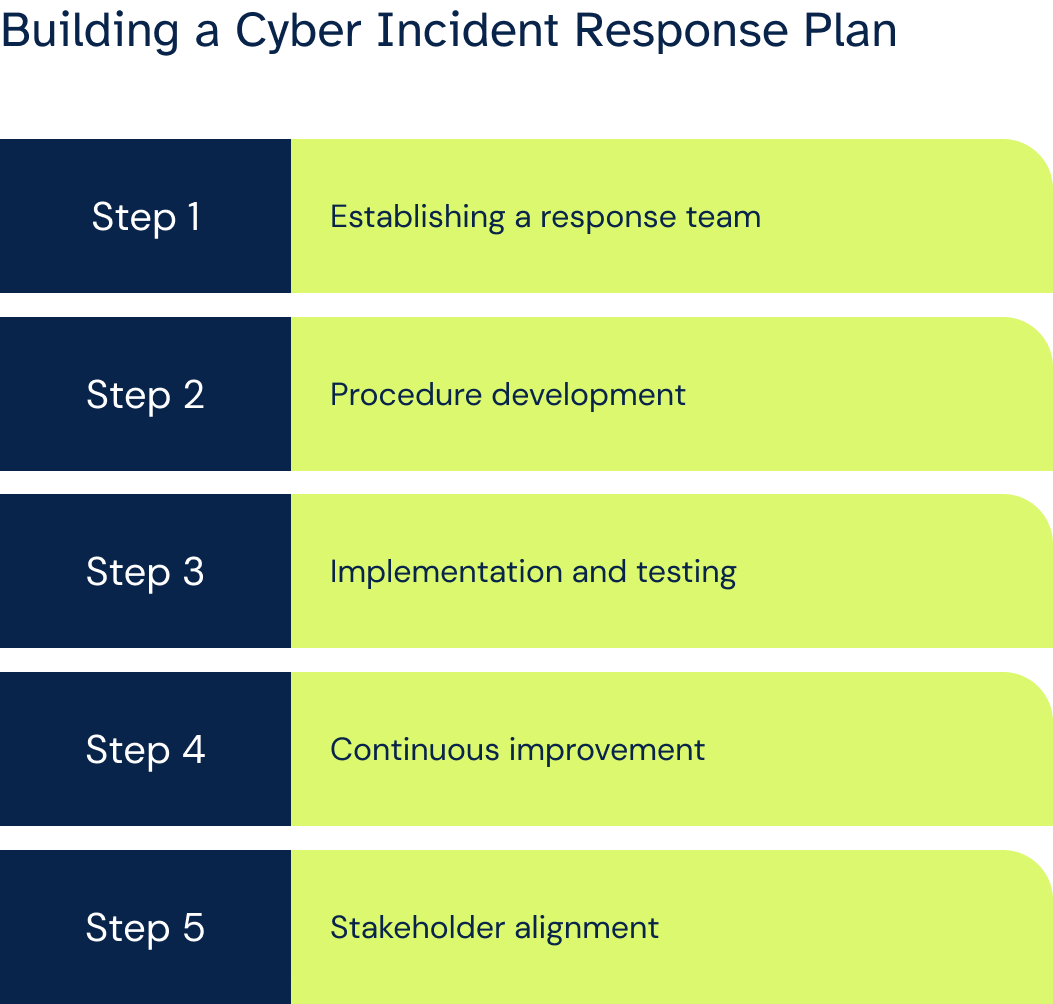While beneficial, digital transformation has opened the door to various modern cyber threats. These threats are becoming increasingly sophisticated, persistent, and difficult to detect, posing risks to organizations of all sizes and industries. From advanced persistent threats (APTs) and ransomware attacks, to data breaches and distributed denial-of-service (DDoS) attacks, a cyber incident's consequences can be devastating.
Proactive preparation and effective incident response are crucial to minimizing the impact of cyber incidents and ensuring business continuity. Organizations must adopt a comprehensive approach to cyber incident management, encompassing everything from employee awareness and training to robust incident response plans and advanced security technologies.
In this article, we will explore cyber incident response, its importance, and strategies organizations can implement.
Introducing cyber incident response
Cyber incident response is the set of structured steps an organization will take to identify, contain, eradicate, and recover from a cyber incident. It's a critical part of an organization's overall cybersecurity strategy, as it helps minimize damage and disruption caused by attacks like data breaches, malware infections, or ransomware.
Key components of an effective cyber incident response plan include:
- Incident detection and analysis: This involves identifying and analyzing potential cyber incidents by implementing robust monitoring and detection systems and prioritizing incidents based on their severity and potential impact. Regulations like the Digital Operational Resilience Act (DORA) or the SEC Cybersecurity Rule also require incident reporting within a specified timeframe to maintain compliance, making early detection crucial.
- Containment and eradication: Once a cyber incident has been detected and analyzed, the next step is to contain the threat and eradicate its source. That may include isolating affected systems, removing malware or unauthorized access, and implementing temporary workarounds or mitigations to prevent further damage or data loss.
- Recovery and restoration: After containing and eradicating the threat, the focus shifts to recovering and restoring affected systems, data, and operations. That may involve restoring backups, rebuilding systems, and implementing additional security controls to prevent similar incidents from occurring again.
- Post-incident review and improvement: Finally, it is essential to conduct a thorough post-mortem review of the incident. Proper root cause analysis includes documenting lessons learned, updating incident response plans and procedures, and implementing necessary changes to enhance the organization's cybersecurity posture.
By incorporating these key components into their cyber incident response plan, organizations can ensure a structured and efficient approach to incident response, minimizing the impact of cyber incidents and enabling a more efficient recovery.
Building a robust cyber incident response plan
Building a well-structured cyber incident response plan is the foundation for swift and decisive action in the face of an attack, minimizing damage and potential financial losses. Meticulous planning is paramount to achieving this.
Below, we outline key strategies to ensure your organization is prepared to defend and respond effectively should a breach occur.

1. Establishing an incident response team
Form a team of individuals with varied areas of expertise and clearly outline what each team member is expected to do during an incident. Include members from IT security, network operations, legal, public relations, human resources, and upper management.
2. Developing incident response procedures
- Incident identification: Define what constitutes a cyber incident. Specify the criteria for determining the severity of a potential incident.
- Incident reporting: Set up incident reporting workflows and create incident report forms to make way for prompt identification, investigation, resolution, and consistent monitoring of incidents.
- Containment and eradication: Specify step-by-step procedures for isolating infected systems, stopping the spread of malware, and removing malicious code or activity.
- Recovery: Document the process of restoring systems, data, and operations. Include methods for validating the integrity of backups before restoration.
- Communication: Pre-establish communication protocols for internal reporting and updates. Draft communication templates for external stakeholders (customers, media) in case of a public breach.
- Post-incident analysis: Define how the team will thoroughly review the incident, analyze the root cause, and implement lessons learned for the future.
3. Implementing and testing the plan
Thoroughly document every aspect of your cyber incident response plan through a centralized knowledge repository for team access during an event. Conduct simulated cyber attacks to test the plan, practice communication, and identify areas for improvement. Configure any necessary security tools, logging mechanisms, or specialized software required for the plan's execution and evidence collection.
4. Continuous improvement and adaptation
Conduct a detailed review after any incident. Analyze what went well and where the plan may have fallen short and adjust procedures accordingly. Since the cyber threat landscape is continuously advancing, reviewing and updating your plan whenever significant changes occur to your systems, vulnerabilities, or regulations is necessary. Monitor emerging cybersecurity trends to ensure your plan remains effective against new attack vectors.
5. Ensuring stakeholder alignment and buy-in
Lastly, you need to secure support from upper management as they are crucial for obtaining the necessary resources and ensuring company-wide adherence to the plan. Involve representatives from critical business units in the planning process, as this helps tailor the response plan to the organization's specific needs. Conduct regular training and simulations for all relevant staff to ensure that they understand their responsibilities and practice the procedures appropriately.
Developing a comprehensive and effective cyber incident response plan is crucial for organizations to minimize the impacts of cyber incidents. By embracing these strategies, organizations can strengthen their resilience against cyber threats, protect their critical assets, maintain business continuity, and safeguard their reputation.
Key takeaways
As organizations increasingly rely on technology and data to drive their operations, the potential consequences of a successful cyber attack can be devastating, leading to financial losses, data breaches, operational disruptions, and irreparable reputational damage.
An effective cyber incident response plan is vital in mitigating the impact of cyber incidents and ensuring business continuity. Its key components include incident detection and analysis, containment and eradication, recovery and restoration, and post-incident review and improvement.
On the other hand, building a robust cyber incident response plan involves establishing a dedicated incident response team, developing clear procedures, and ensuring stakeholder alignment. Organizations must remember that cyber incident response is an ongoing process that requires continuous improvement and adaptation to align with industry best practices and regulatory requirements.
Overall, organizations must invest in comprehensive cyber incident response plans to proactively minimize a cyber incident's impact, protect sensitive data, maintain business continuity, and gain a competitive advantage.
6clicks’ cyber incident response solution
Our Issue and Incident Management module allows users to create custom forms for reporting issues and incidents, link issues and incidents to third parties, build custom reports and treatment plans, and integrate Jira for seamless risk and compliance workflow management.
6clicks offers a comprehensive solution for meeting regulatory requirements that require timely cyber incident reporting and response. The Digital Operational Resilience Act (DORA) regulations and directives, SEC Cybersecurity Rule incident forms and playbooks, and other incident response playbooks and report templates are all available and ready for use in the 6clicks Content Library. Streamline your compliance with regulations like DORA and the SEC Cybersecurity Rule through the 6clicks platform’s robust incident reporting and tracking features and risk, asset, and control management capabilities.
Meanwhile, our Projects & Playbooks module helps you create and share best-practice playbook templates for different incident types. If an incident does occur, you can kick off remediation activities guided by your pre-defined playbook, assigning and tracking tasks and collaborating with team members.
Lastly, we also have Hailey AI — the first-ever AI engine built for risk and compliance that equips users with intuitive automation tools and workflow capabilities.
Learn more about cyber incident response
Written by Louis Strauss
Louis began his career in Berlin where he also founded Dobbel Berlin – Berlin’s curated search engine. Returning to Melbourne to join KPMG, Louis lead the development of software designed to distribute IP and create a platform for us by advisors and clients. While at KPMG, Louis also co-authored Chasing Digital: A Playbook for the New Economy. Louis is accomplished in stakeholder management, requirements gathering, product testing, refinement and project implementation. Louis also holds a Bachelor of Engineering and a Masters of Information Systems from the University of Melbourne.








